-

新人教版高中英语选修2Unit 4 Learning about Language教学设计
This section guides students to pay attention to the typical context of vocabulary use, helps students accumulate vocabulary around the key vocabulary of this unit, and uses the learned words and word chunks in different contexts to deeply understand their meaning and usage, so as to achieve the purpose of review and consolidation.The teaching design activities aim to guide students to pay attention to the typical context in which the target vocabulary is used, as well as the common vocabulary used in collocation, so that students can complete the sentence with correct words. In terms of vocabulary learning strategies, this unit focuses on cultivating students' ability to pay attention to collocation of words and to use word blocks to express meaning.For vocabulary learning, it is not enough just to know the meaning of a single word, but the most important thing is to master the common collocations of words, namely word blocks.Teachers should timely guide students to summarize common vocabulary collocation, such as verb and noun collocation, verb and preposition collocation, preposition and noun collocation, and so on.1. Guide students to understand and consolidate the meaning and usage of the vocabulary in the context, 2. Guide the students to use the unit topic vocabulary in a richer context3. Let the students sort out and accumulate the accumulated vocabulary, establishes the semantic connection between the vocabulary,4. Enable students to understand and master the vocabulary more effectivelyGuiding the Ss to use unit topic words and the sentence patterns in a richer context.

新人教版高中英语选修2Unit 4 Reading for writing教学设计
假定你是英国的Jack,打算来中国旅行,请你给你的中国笔友李华写一封信,要点如下:1.你的旅行计划:北京→泰山→杭州;2.征求建议并询问他是否愿意充当你的导游。注意:1.词数80左右(开头和结尾已给出,不计入总词数);2.可以适当增加细节,以使行文连贯。参考词汇:故宫 the Forbidden City;泰山 Mount TaiDear Li Hua,I'm glad to tell you that 'm going to visit China.First,I am planning to visit Beijing,the capitalof China,where I am looking forward to enjoying the Great Wall,the Forbidden City and somebeautiful parks.Then I intend to go to visit Mount Tai in Shandong Province.I've heard that it is one ofthe most famous mountains in China and I can't wait to enjoy the amazing sunrise there.After that,I amalso going to Hangzhou.It is said that it is a beautiful modern city with breathtaking natural sights,among which the West Lake is a well- known tourist attraction.What do you think of my travel plan? Will you act as my guide? Hope to hear from you soon.

新人教版高中英语选修2Unit 4 Using langauge-Listening教学设计
The theme of the listening section is " talking about scenery and culture along a journey."The part is designed to further lead the students to understand Canadian natural geography and social environment, and integrated into the cultural contrast by mentioning the long train journey from Beijing to Moscow routes. On this basis, the part activates students related travel experience, lets the student serial dialogue, guides the student to explore further the pleasure and meaning of the long journey, and Chinese and foreign cultural comparison.The part also provides a framework for the continuation of the dialogue, which is designed to provide a framework for students to successfully complete their oral expressions, and to incorporate an important trading strategy to end the dialogue naturally.1. Help students to understand and master some common English idioms in the context, and experience the expression effect of English idioms.2. Guide the students to understand the identity of different people in the listening context, and finish the dialogue according to their own experience.3. Instruct the students to use appropriate language to express surprise and curiosity about space and place in the dialogue, and master the oral strategy of ending the dialogue naturally.1. Instruct students to grasp the key information and important details of the dialogue.2. Instruct students to conduct a similar talk on the relevant topic.

新人教版高中英语选修2Unit 5 Learning about Language教学设计
The purpose of this section of vocabulary exercises is to consolidate the key words in the first part of the reading text, let the students write the words according to the English definition, and focus on the detection of the meaning and spelling of the new words. The teaching design includes use English definition to explain words, which is conducive to improving students' interest in vocabulary learning, cultivating their sense of English language and thinking in English, and making students willing to use this method to better grasp the meaning of words, expand their vocabulary, and improve their ability of vocabulary application. Besides, the design offers more context including sentences and short passage for students to practice words flexibly.1. Guide students to understand and consolidate the meaning and usage of the vocabulary in the context, 2. Guide the students to use the unit topic vocabulary in a richer context3. Let the students sort out and accumulate the accumulated vocabulary, establishes the semantic connection between the vocabulary,4. Enable students to understand and master the vocabulary more effectivelyGuiding the Ss to use unit topic words and the sentence patterns in a richer context.Step1: Read the passage about chemical burns and fill in the blanks with the correct forms of the words in the box.

新人教版高中英语选修2Unit 5 Reading and thinking教学设计
The theme of this activity is to learn the first aid knowledge of burns. Burns is common in life, but there are some misunderstandings in manual treatment. This activity provides students with correct first aid methods, so as not to take them for granted in an emergency. This section guides students to analyze the causes of scald and help students avoid such things. From the perspective of text structure and collaborative features, the text is expository. Expository, with explanation as the main way of expression, transmits knowledge and information to readers by analyzing concepts and elaborating examples. This text arranges the information in logical order, clearly presents three parts of the content through the subtitle, accurately describes the causes, types, characteristics and first aid measures of burns, and some paragraphs use topic sentences to summarize the main idea, and the level is very clear.1. Guide students to understand the causes, types, characteristics and first aid methods of burns, through reading2. Enhance students’ ability to deal withburnss and their awareness of burns prevention3. Enable students to improve the ability to judge the types of texts accurately and to master the characteristics and writing techniques of expository texts.Guide students to understand the causes, types, characteristics and first aid methods of burns, through readingStep1: Lead in by discussing the related topic:1. What first-aid techniques do you know of ?CPR; mouth to mouth artificial respiration; the Heimlich Manoeuvre

新人教版高中英语选修2Unit 5 Using langauge-Listening教学设计
The theme of this section is to learn how to make emergency calls. Students should learn how to make emergency calls not only in China, but also in foreign countries in English, so that they can be prepared for future situations outside the home.The emergency telephone number is a vital hotline, which should be the most clear, rapid and effective communication with the acute operator.This section helps students to understand the emergency calls in some countries and the precautions for making emergency calls. Through the study of this section, students can accumulate common expressions and sentence patterns in this context. 1.Help students accumulate emergency telephone numbers in different countries and learn more about first aid2.Guide the students to understand the contents and instructions of the telephone, grasp the characteristics of the emergency telephone and the requirements of the emergency telephone.3.Guide students to understand the first aid instructions of the operators.4.Enable Ss to make simulated emergency calls with their partners in the language they have learned1. Instruct students to grasp the key information and important details of the dialogue.2. Instruct students to conduct a similar talk on the relevant topic.Step1:Look and discuss:Match the pictures below to the medical emergencies, and then discuss the questions in groups.

新人教版高中英语选修2Unit 2 Reading for writing教学设计
The theme of this section is to express people's views on studying abroad. With the continuous development of Chinese economic construction, especially the general improvement of people's living standards, the number of Chinese students studying abroad at their own expense is on the rise. Many students and parents turn their attention to the world and regard studying abroad as an effective way to improve their quality, broaden their horizons and master the world's advanced scientific knowledge, which is very important for the fever of going abroad. Studying abroad is also an important decision made by a family for their children. Therefore, it is of great social significance to discuss this issue. The theme of this section is the column discussion in the newspaper: the advantages and disadvantages of studying abroad. The discourse is about two parents' contribution letters on this issue. They respectively express their own positions. One thinks that the disadvantages outweigh the advantages, and the other thinks that the advantages outweigh the disadvantages. The two parents' arguments are well founded and logical. It is worth noting that the two authors do not express their views on studying abroad from an individual point of view, but from a national or even global point of view. These two articles have the characteristics of both letters and argumentative essays1.Guide the students to read these two articles, and understand the author's point of view and argument ideas2.Help the students to summarize the structure and writing methods of argumentative writing, and guides students to correctly understand the advantages and disadvantages of studying abroad3.Cultivate students' ability to analyze problems objectively, comprehensively and deeply
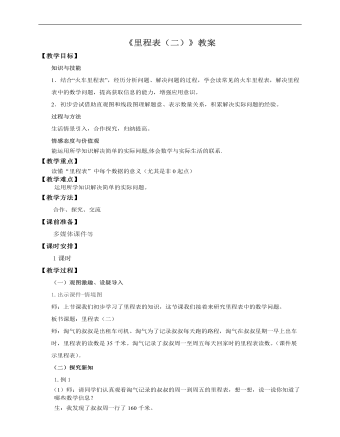
小学数学北师大版三年级上册《第五课里程表(二)》教案说课稿
(一)观图激趣、设疑导入 1.出示课件-情境图师:上节课我们初步学习了里程表的知识,这节课我们接着来研究里程表中的数学问题。板书课题:里程表(二)师:淘气的叔叔是出租车司机。淘气为了记录叔叔每天跑的路程,淘气在叔叔星期一早上出车时,里程表的读数是35千米。淘气记录了叔叔周一至周五每天回家时的里程表读数。(课件展示里程表)。(二)探究新知1.例1(1)师:请同学们认真观看淘气记录的叔叔的周一到周五的里程表,想一想,说一说你知道了哪些数学信息?生:我发现了叔叔周一行了160千米。 师:同学们他说找到数学信息对吗?生:160千米不是星期一的行驶里程,应该是星期一晚上里程表上的读数。 星期二里程表上的读数是350,。生:。。。。师:同学们找的数学信息非常多,非常全面。(2)小组讨论交流:淘气根据题意画了一个图,你看懂了吗?与同伴说一说。
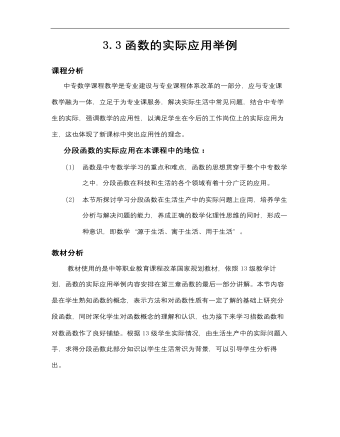
【高教版】中职数学基础模块上册:3.3《函数的实际应用举例》教学设计
课程分析中专数学课程教学是专业建设与专业课程体系改革的一部分,应与专业课教学融为一体,立足于为专业课服务,解决实际生活中常见问题,结合中专学生的实际,强调数学的应用性,以满足学生在今后的工作岗位上的实际应用为主,这也体现了新课标中突出应用性的理念。分段函数的实际应用在本课程中的地位:(1) 函数是中专数学学习的重点和难点,函数的思想贯穿于整个中专数学之中,分段函数在科技和生活的各个领域有着十分广泛的应用。(2) 本节所探讨学习分段函数在生活生产中的实际问题上应用,培养学生分析与解决问题的能力,养成正确的数学化理性思维的同时,形成一种意识,即数学“源于生活、寓于生活、用于生活”。教材分析 教材使用的是中等职业教育课程改革国家规划教材,依照13级教学计划,函数的实际应用举例内容安排在第三章函数的最后一部分讲解。本节内容是在学生熟知函数的概念,表示方法和对函数性质有一定了解的基础上研究分段函数,同时深化学生对函数概念的理解和认识,也为接下来学习指数函数和对数函数作了良好铺垫。根据13级学生实际情况,由生活生产中的实际问题入手,求得分段函数此部分知识以学生生活常识为背景,可以引导学生分析得出。
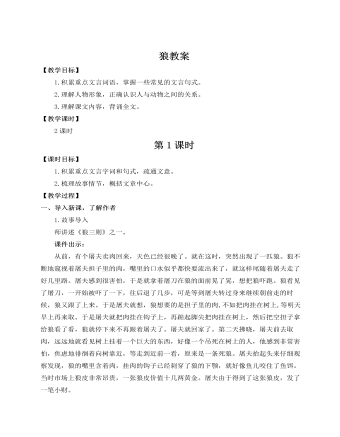
人教部编版七年级语文上册狼教案
(学生交流,教师引导,总结方法)(1)方法1:主谓之间要停顿。【示例】一狼/得骨/止;其一/犬坐于前。(2)方法2 :谓语与宾语之间要停顿。【示例】顾/野有麦场;乃悟/前狼/假寐 。(3)方法3:连词前面可以停顿。【示例】后狼止/而前狼又至;意将/隧入/以攻其后也。(4)方法4 :发语词后面要停顿。【示例】盖/以诱敌。(全班齐读课文,读顺文章)师小结:理解文意,固然可以运用停顿技巧,但最重要的方法是弄懂字词大意、文句意思。理解了文意,才能读准句读,有利于我们读顺文章。【设计意图】本环节旨在通过学习互助的方式,调动学生的学习热情,充分发挥学生的学习积极性和主动性,进而理解文意,读顺文章。教师及时点拨,适时归纳文言释词方法、句式和停顿划分小技巧,实现知识学习与技能掌握的统一。四、细读课文,读懂内容1.概括文章情节文章讲述了屠户杀狼的故事。按照事件的发展,情节一般可以分为开端(发生)、发展、高潮和结局。请同学们细读课文后,用词语概括这个故事的发展经过。(生交流后,师明确)
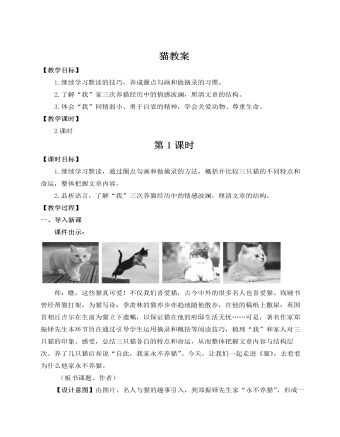
人教部编版七年级语文上册猫教案
【设计意图】此环节聚焦第三只猫的悲剧,让学生通过品析语言,想象猫的内心冤屈,同时结合创作背景,逐层深入地理解课文主题及作者的人文情怀。三、拓展延伸1.同学们,你喜欢文中哪一只猫呢?为什么?(生自由讨论)预设(1)喜欢第一只或第二只猫,因为它好看,性情可爱、活泼。(2)喜欢第三只猫,它更可怜,更需要关爱。(3)都喜欢,因为生命不分高低贵贱,它们是平等的。我们要尊重每一个生命。2.如果你是第三只猫,应该怎么做才能避免悲剧的发生呢?(分组讨论,全班交流。可从“自省”“自强”“完善自我”等角度讨论)预设(1)如果我是第三只猫,首先要自我反省,知道自己哪些方面不够优秀,找到不足,然后不断努力,完善自我。(2)不能埋怨别人,不能自甘堕落,不能放弃自己。结束语:文章以“我家养了好几次猫,结局总是失踪或死亡”总领全文,以“自此,我家永不养猫”收束全文,结构紧凑。文章以猫写人,用猫的世界折射世态人情。
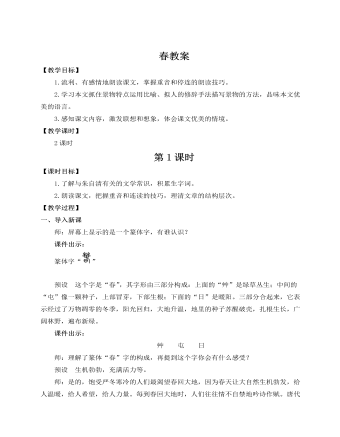
人教部编版七年级语文上册春教案
本文具有很强的画面感,凸显出绘画美,虽是散文,却满贮诗意,正是文中有画,画中有诗。作者从色泽、层次和动态上向人们展示了一幅栩栩如生的春景图。作者笔下的春景图色泽鲜艳,不仅有象征希望的“嫩嫩的,绿绿的”小草,还有“红的像火,粉的像霞,白的像雪”的繁花,也有温暖的“红红的”太阳的脸和“黄晕的”灯光,这些色彩描绘出了一个生机勃勃而又安静祥和的春天。在描写春景的时候,作者还通过有层次感的描写使景物意蕴悠长,例如对春雨的描写是从“人家屋顶上”到“小路上”“石桥边”再到“地里”,从远至近,层次分明。另外,朱自清使用精妙的语言向读者展示了动态(生机)美,在他笔下,花是“赶趟儿”的,蜜蜂是“闹着”的,气味儿是“酝酿”的,一切都是“生长着”的,洋溢着盎然的生机。作者从总体上描绘春景,大地回春、万物复苏的景象就活生生地展现在了读者眼前。
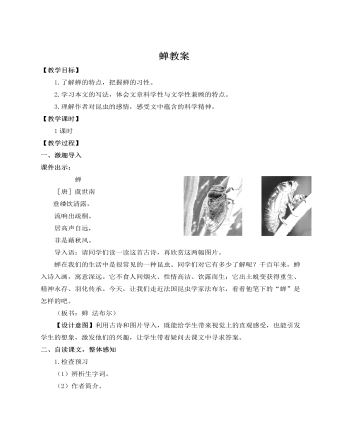
人教部编版语文八年级上册蝉教案
鲁迅曾把《昆虫记》称为“讲昆虫的故事”“讲昆虫生活”的楷模。鲁迅说:“他的著作还有两种缺点:一是嗤笑解剖学家,二是用人类道德于昆虫界。”周作人说:“法布尔的书中所讲的是昆虫的生活,但我们读了却觉得比看那些无聊的小说戏剧更有趣味,更有意义。”巴金说:“《昆虫记》融作者毕生的研究成果和人生感悟于一炉,以人性观照虫性,将昆虫世界化作供人类获取知识、趣味、美感和思想的美文。”传统文化玉蝉:蝉意喻人生蝉在古人的心目中地位很高,向来被视为纯洁、清高、通灵的象征。玉蝉究其用途,大体可分为四种:一是佩蝉,是专门佩戴在人身上以作装饰和避邪用,示高洁;一种为冠蝉,是作为饰物缀于帽子上的,表示高贵;一种是琀蝉,以蝉的羽化比喻人能重生,寓指精神不死,再生复活;还有一种是镇蝉,做镇纸用的文房用品,多出现在明代以后,前三种蝉属于高古玉,主要产生在商周至战汉时期。
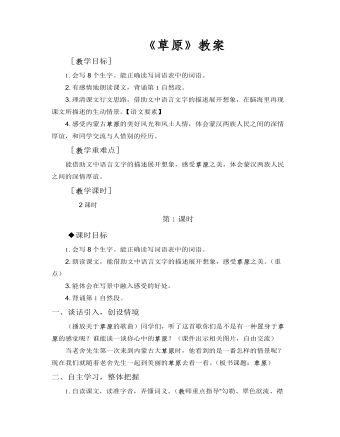
部编版六年级语文上册《草原》教案
1.会写8个生字。能正确读写词语表中的词语。2.朗读课文,能借助文中语言文字的描述展开想象,感受草原之美。(重点)3.能体会在写景中融入感受的好处。4.背诵第1自然段。一、谈话引入,创设情境(播放关于草原的歌曲)同学们,听了这首歌你们是不是有一种置身于草原的感觉呢?谁能谈一谈你心中的草原?(课件出示相关图片,自由交流)当老舍先生第一次来到内蒙古大草原时,他看到的是一番怎样的情景呢?现在我们就随着老舍先生一起到美丽的草原去看一看。(板书课题:草原)
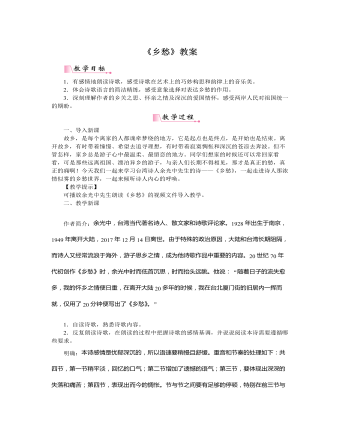
部编版语文九年级上册《乡愁》教案
【教学提示】教师可以示范分析其中两个意象,注意引导学生把握普通事物之所以形成诗歌意象的原因,领悟诗歌意象的内蕴意义。3.诗人在诗中运用了许多表修饰、限制的形容词和数量词,它们有什么特点?它们共同突出了诗歌中四个意象的什么特征?请你简要说说它们在诗歌中的表达效果。明确:“一枚”“一张”“一方”“一湾”四个数量词和“小小的”“窄窄的”“矮矮的”“浅浅的”四个形容词,都是面积小重量轻的词语。然而,邮票虽小,却承载了母子深情;船票虽窄,却联系着夫妻之间浓浓的恋情;矮矮的坟墓,盛不下生死离情之痛;海峡虽浅,隔断的思乡哀愁却是如此之深。这一系列限定修饰词,都反衬了乡愁的浓郁。目标导学四:把握诗歌艺术特征探究:本诗除了在意象选取上颇费心思,在结构艺术上也见出笔力。请同学们说说,本诗还具有哪些令你欣赏的艺术特征。
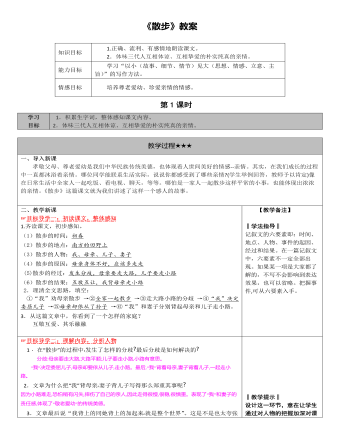
部编版语文七年级上册《散步》教案
二、教学新课?目标导学一:品读语言之美 请找出你认为最妙的一个词、最美的一句话,最精彩的一段文字,读一读,品一品。如生动的景物描写;贴切的修辞;特殊的句式;含义深刻的语句;精当的用词……1.写景的句子 (1)第四自然段“这南方初春的田野,大块小块的新绿随意地铺着,有的浓,有的淡;树上的嫩芽也密了;田里的冬水也咕咕地起着水泡。”分析:这段描绘了新绿、嫩芽、冬水,展现了春天的气息,生命的呼唤,写得富有诗意,读后使人似乎闻到了乡间田野泥土的芬芳,衬托了一家人散步时祥和、欢乐的情绪。 (2)第七自然段“她的眼随小路望去:那里有金色的菜花,两行整齐的桑树,尽头一口水波粼粼的鱼塘。”
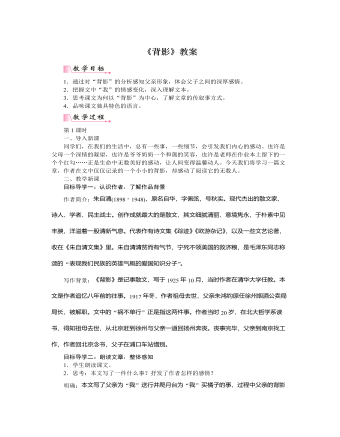
部编版语文八年级上册《背影》教案
目标导学四:学以致用,学习刻画形象点拨:作者在描写父亲背影的过程中,综合运用了外貌描写与动作描写的方法。在描写外貌时,抓住父亲穿着简陋与肥胖的典型特征,在动作描写中也集中体现出攀月台不易的形象。作者这种抓住典型特征做简要勾画来表现出人物形象的方法叫白描手法。引导:在你的印象中,是否也有人给你留下过如此感动的回忆呢?请你仔细回忆当时的场景,具体到对方做了什么动作,他(她)是什么形象,或说了什么话,将这些记录下来,记住要表现描写对象的主要特征。第2课时一、复习回顾、引入新课在上一课时,我们仔细分析了朱自清先生刻画的“背影”形象,这个形象如此令人感动。然而细心的同学恐怕已经明显地感受到朱先生的情感在文中有着极大的变化,而父亲对孩子的感情也未必就是爬月台买橘子那样简单,这节课,就让我们更加深入地走进本文的情感世界。

部编版语文七年级上册《狼》教案
二、教学新课?目标导学一:鉴赏描写,分析形象1.课文中哪些语句写出狼的贪婪凶恶、狡诈阴险的本性的?贪婪凶恶:缀行甚远;一狼得骨止一狼仍从;后狼止而前狼又至;而两狼之并驱如故。狡诈阴险:一狼径去,其一犬坐于前。目似瞑,意暇甚;意将遂入以攻其后也。2.文章是如何来刻画屠户的形象的?(要求从人物描写方法并以课文例句加以分析)(1)心理描写:惧——投骨避狼;大窘——骨尽狼仍从;恐——前后受其敌;悟——刀劈两狼。作者写出了屠户从妥协退让,到当机立断、奋起杀狼这一心理发展变化的过程。(2)动作描写:“投以骨”“复投之”写屠户试图投骨避狼,结果无效。“顾”“奔”“倚”“弛”“持”五个动词,写屠户迅速抢占有利的地形,保卫自己,准备反击。“暴起”“劈”“毙”写屠户趁一狼径去,一狼假寐的有利时机,当机立断,奋起杀狼,取得胜利。“转视”“断”“毙”等动词写屠户高度警惕,果断出击,再获全胜。
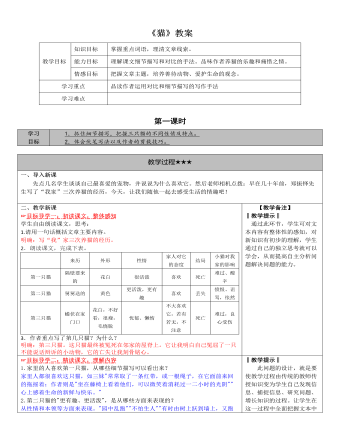
部编版语文七年级上册《猫》教案
目标导学二:精读课文,理解内容1.家里的人喜欢第一只猫,从哪些细节描写可以看出来?家里人都很喜欢这只猫,如三妹"常常取了一条红带,或一根绳子,在它面前来回的拖摇着;作者则是"坐在藤椅上看着他们,可以微笑着消耗过一二小时的光阴""心上感着生命的新鲜与快乐。"2.第二只猫的"更有趣、更活泼",是从哪些方面来表现的?从性情和本领等方面来表现。"园中乱跑""不怕生人""有时由树上跃到墙上,又跑到街上"等是表现它的性情;"会爬树""捉蝴蝶""会捉鼠"。3.第三只猫的“可厌”,是从哪些方面来描写的?是从形态和性情等方面来写的。“不好看,又很瘦”“毛被烧脱了好几块”“忧郁”“懒惰”。4.“我”根据什么判定芙蓉鸟是这只猫咬死的?是谁咬死了芙蓉鸟?根据是什么?“那只花白猫对于这一对黄鸟,似乎也特别注意,常常跳到桌子上对鸟笼凝望着。”是只凶恶的黑猫把鸟咬死。根据是:“一只黑猫飞快的逃过露台,嘴里衔着一只黄鸟”。5.为什么“我”对于第三只猫的死亡比前两只猫的亡失更“难过得多”?
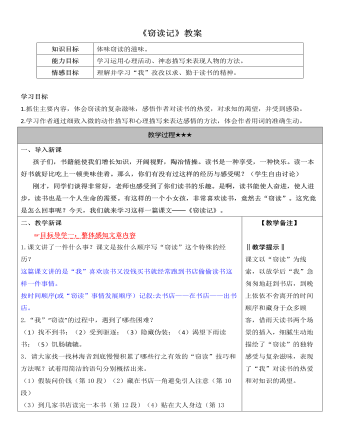
部编版语文七年级上册《窃读记》教案
(2)有时我贴在一个大人的身边,仿佛我是与他同来的小妹妹或者女儿。“贴”字形象地描绘出“我”躲在大人身边窃读的情形,出神入化地反映了“我”害怕被哄赶,又不愿意离开书店的心情。(3)我慌忙把眼睛送上书架,装作没看见。“送上”一词形象地描绘出“我”躲避店员时的慌乱与惧怕。3.理解下面句子的含义(1)记住,你是吃饭长大的;读书长大;也是在爱里长大的。吃饭长大,是人的生存需要;读书长大,是“我”在窃读过程中,不断获得知识,“我”的精神世界变得丰富、精彩;而后一次“窃读”,店员明知“我”不会买书,却依然留书给“我”“借读”。让我领悟了“爱”的真谛,也最终懂得了“我是在爱里长大的”。(2)我很快乐,也很惧怕---这种窃读的滋味!“我”在阅读中感受着书籍所带来的智慧与快乐,却时刻害怕被店员或老板发现受到训斥和哄赶,这种书内世界的吸引与沉迷,书外世界的担忧与紧张,使快乐与惧怕紧密地交织在一起,形成一种复杂的、难以言说的感受,正是窃读的滋味。



